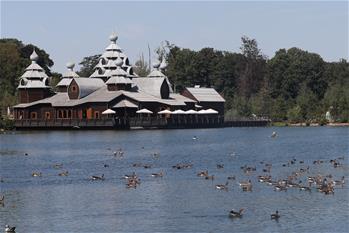LOS ANGELES, Sept. 9 (Xinhua) -- A new theory suggests that some lakes on Saturn's largest moon formed when pockets of nitrogen blew out basins that filled with methane, according to a release of NASA's Jet Propulsion Laboratory (JPL) on Monday.
Titan is the only planetary body in the solar system other than Earth known to have stable liquid on its surface.
But instead of water raining down from clouds and filling lakes and seas as on Earth, on Titan it is methane and ethane -- hydrocarbons that behave as liquids in Titan's frigid climate, said the JPL.
Most existing models that lay out the origin of Titan's lakes show liquid methane dissolving the moon's bedrock of ice and solid organic compounds, carving reservoirs that fill with the liquid.
The new, alternative models for some of the smaller lakes turns that theory upside down. It proposes that the pockets of liquid nitrogen in Titan's crust warmed, turning into explosive gas that blew out craters, which then filled with liquid methane.
The new theory explains why some of the smaller lakes near Titan's north pole, like Winnipeg Lacus, appear in radar imaging to have very steep rims that tower above sea level, said the JPL.
The radar data were gathered by the Cassini Saturn Orbiter -- a mission managed by the JPL during its last close flyby of Titan, as the spacecraft prepared for its final plunge into Saturn's atmosphere two years ago.
The work, published Monday in Nature Geosciences, meshes with other Titan climate models showing the moon may be warm compared to how it was in earlier Titan "ice ages."
Over the last half-billion or billion years on Titan, methane in its atmosphere has acted as a greenhouse gas, keeping the moon relatively warm, said the JPL.
"This is a completely different explanation for the steep rims around those small lakes, which has been a tremendous puzzle," said Cassini Project Scientist Linda Spilker.
"As scientists continue to mine the treasure trove of Cassini data, we'll keep putting more and more pieces of the puzzle together. Over the next decades, we will come to understand the Saturn system better and better," Spilker said.

















